April 7, 2015
Forget Fake Meat, Fall In Love With Chicken Again
Bored of the original white meat? You probably just need a few new dishes.
In her latest book “A Bird In The Hand,” food writer and cook Diana Henry praises chicken as a staple that can be both creative and comforting. Try your hand at her inventive dishes and tune in Wednesday, April 8, at 12:20 p.m. to hear her talk about what she calls the most lovable and versatile protein around.
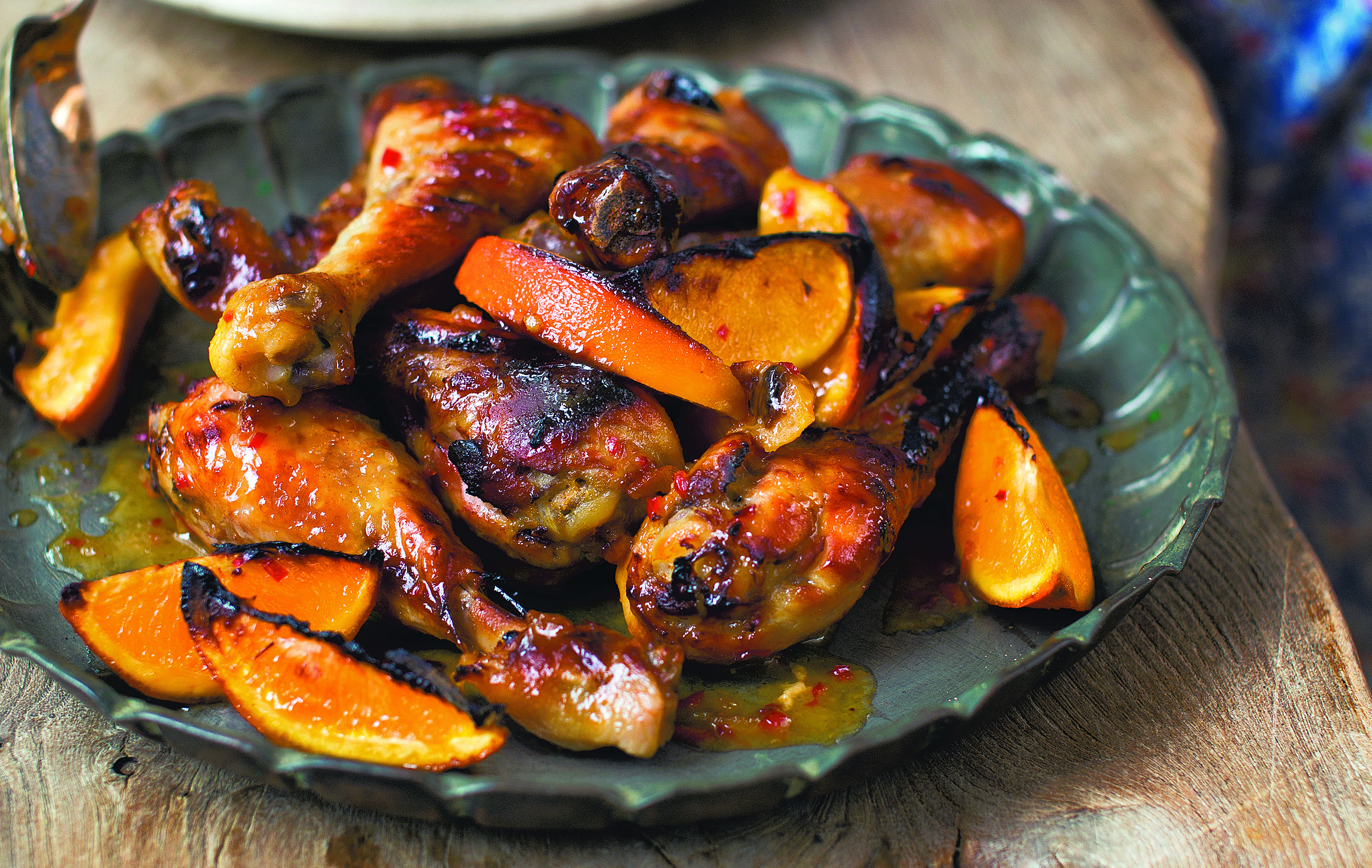
Bourbon and Marmalade-Glazed Drumsticks
This is lovely with a salad that cuts through the sweetness—watercress and shaved fennel is good—with a buttermilk dressing. Brown rice or spelt are perfect alongside.
Serves 4
8 drumsticks
½ cup orange marmalade, divided
4 tsp Dijon mustard, divided
3 tbsp bourbon
2 garlic cloves, crushed
2 red chiles, halved, seeded, and minced
2 oranges (preferably thin-skinned), halved and cut into ¾-inch thick wedges
salt and pepper
Make small slits in the drumsticks with a sharp knife. In a small bowl, mix 2 tablespoons of the marmalade and 1 teaspoon of the mustard. Set aside. In another bowl, mix the remaining marmalade—squash it down with the back of spoon to break it up—with the remaining mustard, the bourbon, garlic, and chiles. Put the chicken into this and roll it around so it gets well coated. Cover and put in the fridge for a few hours (or leave it all day, or overnight if you prefer). Bring it to room temperature before cooking.
When you’re ready to cook, preheat the oven to 410°F. Put the drumsticks—with all the marinade and any juices—into a roasting pan or gratin dish where they can lie in a single layer. Add the orange wedges. Turn the chicken and oranges over so that the oranges get coated in the marinade, too. Season everything with salt and pepper.
Roast for 40 to 45 minutes, or until the drumsticks are cooked through, glossy, and almost caramelized. In the last 10 minutes of the cooking time, brush the top of the drumsticks with the reserved marmalade and mustard.
Transfer the oranges and drumsticks to a serving platter and spoon some of the juices evenly over the top. You can’t eat the orange skin, but the flesh is nice: sweet and tart.
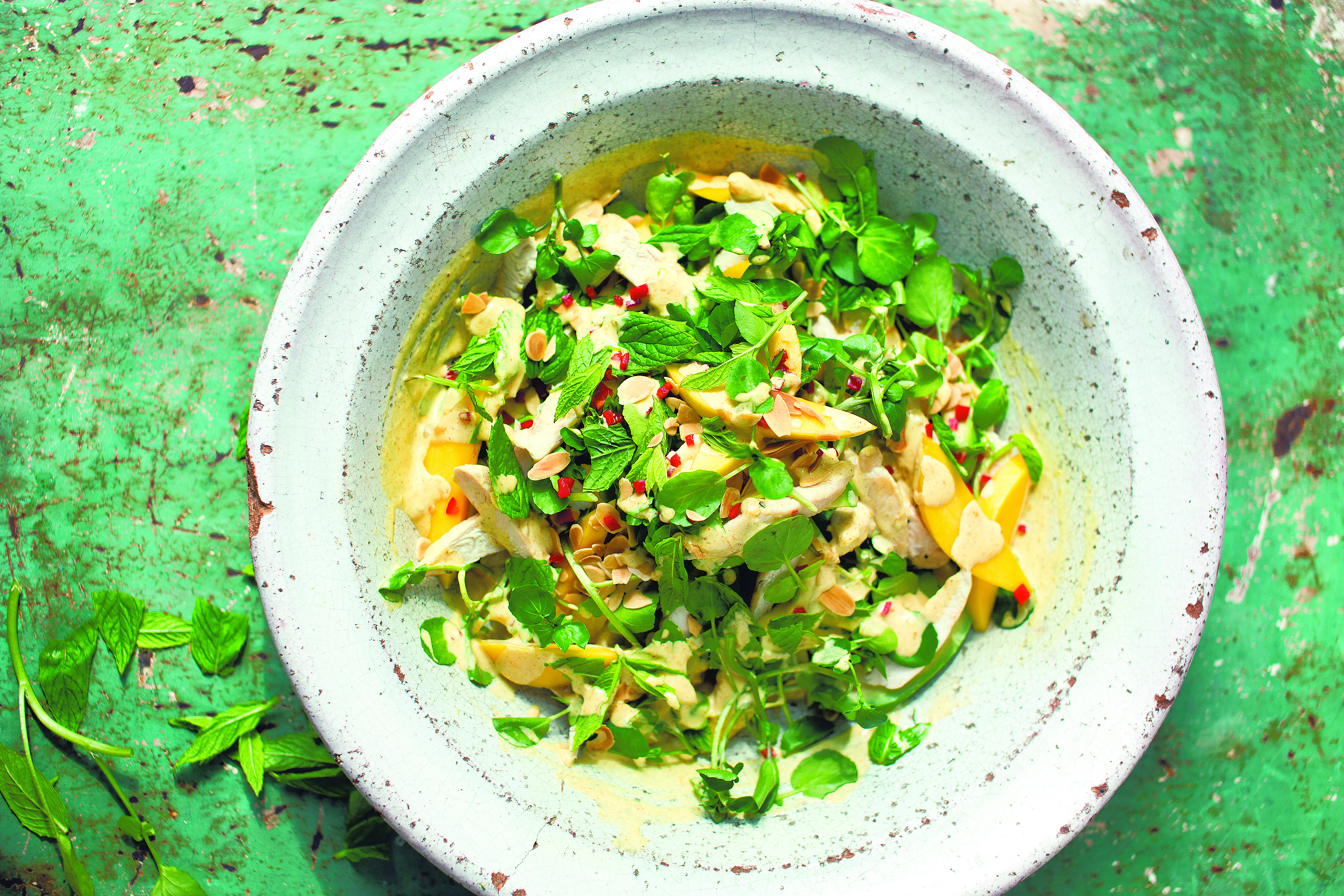
My Coronation Chicken With Mango And Avocado
Coronation chicken is the sort of British dish that makes the French laugh (it is, after all, a mixture of meat and fruit, something they find rather alien), but it is one of my favorite things. Usually it looks somewhat unappetizing, though, because you get a pile of mayo-smothered chicken served alongside shreds of iceberg lettuce, all of it scattered with some pale and sad-looking sliced almonds. I wanted to take Coronation chicken to new heights, and to make it into a respectable salad. This is what I came up with. It makes a lovely summer lunch.
Serves 8 as a main course salad
For the salad
salt and pepper
2¼lb skinless, boneless chicken breasts, or chicken tenders
2 tbsp olive oil, plus 2 tbsp more to dress the salad
2 just-ripe mangoes
2 ripe avocados
juice of 2 limes, divided
2¾oz watercress or baby spinach
1 red chile, halved, seeded,
and shredded
3 tbsp toasted sliced almonds
For the dressing
1 tbsp curry powder, or to taste
½ tsp ground ginger
11/3 cups mayonnaise
½ cup Greek yogurt
7 tbsp mango chutney, chopped if it is chunky
a little milk
chili sauce, to taste (optional)
leaves from 7 sprigs of mint, torn
Season the chicken and heat the 2 tablespoons of oil in a
large skillet. Sauté it until golden all over, then add about
3 tablespoons of water. Cover and let the chicken cook. How long this takes depends on whether you are using breasts or tenders. Cut a piece of chicken through the middle to check (it should have no trace of pink). Let cool completely. Using a fine-bladed, really sharp knife, cut into neat slices. Season all over.
Gently combine all of the ingredients for the dressing together except the chili sauce and mint. It should be about the thickness of heavy cream (though a little chunky because it has chutney pieces in it). Taste for seasoning and heat and add chili sauce, if using. Stir in the mint.
Peel the mangoes and cut the “cheeks” off each side (the parts lying right next to the seed), cutting really close to the seed so you remove the plumpest part of the mango you can. Cut them into neat slices about 1/8 inch thick. (You can remove the rest of the flesh, of course, but it is difficult to cut into neat slices. Best remove it and keep it for something else.)
Halve the avocados, remove the seeds, and slice the flesh. Carefully peel the skin from each slice. Squeeze some fresh lime juice over them to keep them from discoloring. Season. Gently toss the salad leaves with the sliced mango and avocado, the chile, the remaining lime juice, and 2 tablespoons of olive oil (this gives the salad a nice gloss). Season to taste.
Put the salad on a big platter or a broad shallow bowl and add the chicken. Drizzle some of the dressing over it and scatter the almonds on top. Serve the rest of the dressing in a pitcher. I like a bowlful of wild and brown rice with this, either warm, or dressed with vinaigrette and left to get to room temperature.
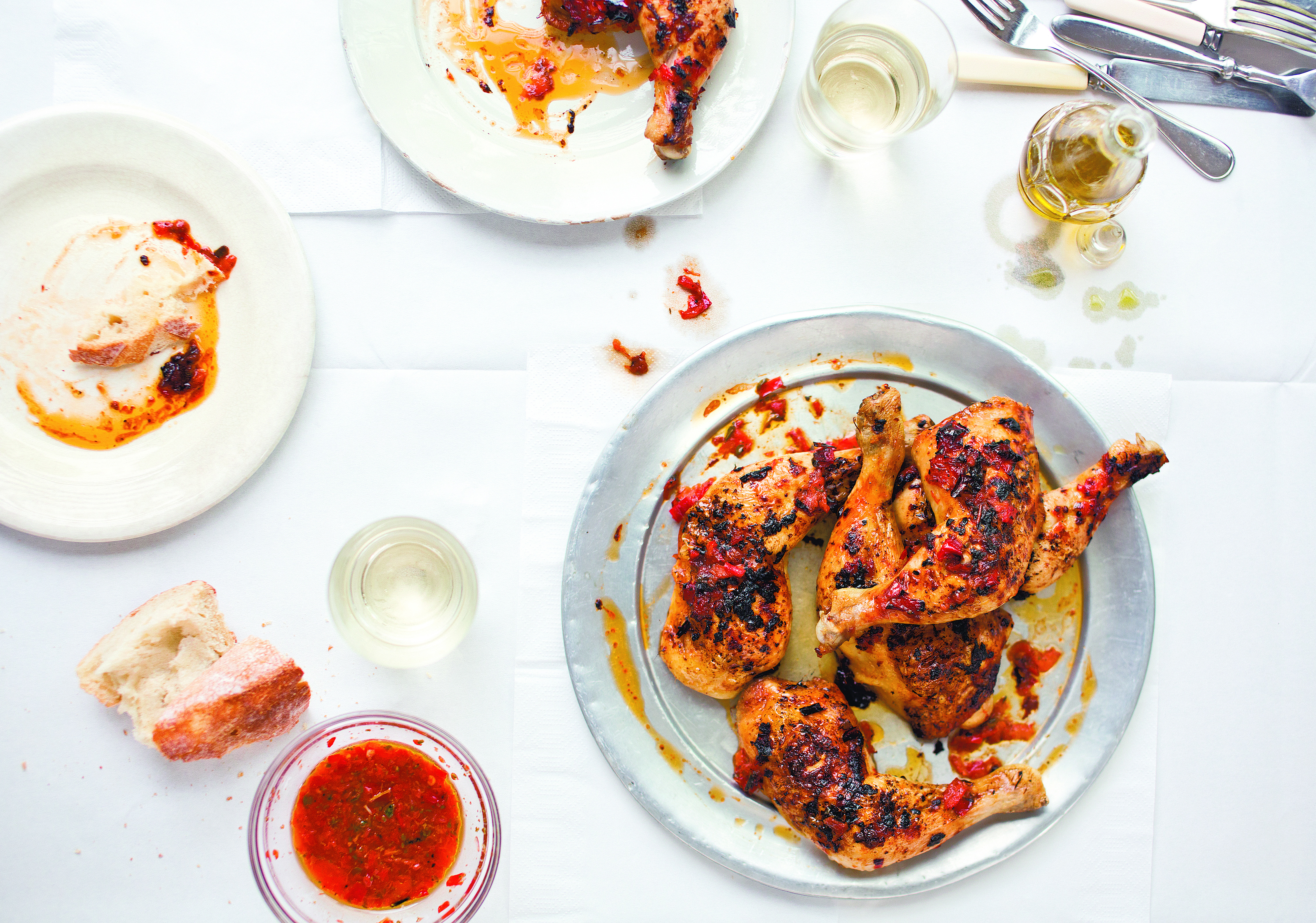
Chicken Piri Piri
Whenever I go to Portugal my first pit stop is the same: a chicken piri piri restaurant that is little more than a shack (there are no real walls, just bits of matting hung on a frame) at the side of a dusty road. The place is full of Portuguese families noisily shouting for more piri piri sauce. Nothing else is served. Just frango piri piri, salad, and french fries or bread. The chicken is cooked on huge braziers. It’s hard to replicate the special smokiness when you cook it at home, but you can almost get it. The Portuguese piri piri I’ve eaten always has a great red color and is slightly sweet. I’ve tried to achieve this here by adding roast bell pepper.
It’s difficult to be prescriptive about cooking times since it depends on your broiler (and some domestic broilers are very poor), so these instructions are guidelines only. If you prefer to roast your chicken pieces, put them on a rack set in a roasting pan and cook for 40 minutes in an oven preheated to 425°F.
In Portugal, whole small chickens or squab chickens—spatchcocked—are cooked this way, so use those if you prefer (get your butcher to do the spatchcocking). There is enough piri piri here for four squab chickens. Roast them just as you would leg quarters.
Serves 6
1 small red bell pepper
3 tbsp olive oil, divided
4 red chiles
4 garlic cloves, crushed
2 tsp dried oregano, or chopped fresh oregano leaves
½ tsp chili flakes
2 tbsp red wine vinegar
juice of 2 lemons
½ tsp superfine sugar
1 tsp sea salt flakes
6 skin-on, bone-in chicken leg quarters
Preheat the oven to 375°F. Halve and seed the bell pepper, brush with a little of the oil, put into a small roasting pan, and roast for about 25 minutes, or until the flesh is soft. Peel the skin off if it comes away easily; leave it if it doesn’t. Chop roughly, then crush in a mortar and pestle. Set aside.
Remove the stems from the chiles and seed them. Chop finely, then place in an empty mortar with the garlic, oregano, and chili flakes. Pound to a rough paste, then add the vinegar, lemon juice, sugar, salt, remaining oil, and red bell pepper. Put the chicken into a broad, shallow dish and pour most of the marinade onto it. Roll the chicken pieces over to coat, cover with plastic wrap, and put in the fridge for about 4 hours (overnight is even better), rolling the chicken over a couple of times. Bring to room temperature before cooking.
Heat your broiler and arrange the chicken on the broiler rack, skin-side up. Place the rack 4 inches from the heat and broil for 12 minutes on each side, reducing the heat halfway through. Baste every so often with the juices or a little more marinade.
Move the chicken another 4 inches away from the heat and broil for another 6 or 7 minutes on each side. The chicken should be cooked through (make sure the juices are clear and there is no trace of pink), sizzling, and dark red.
Serve immediately with a lettuce, cucumber, and tomato salad, and fried potatoes or coarse country bread.
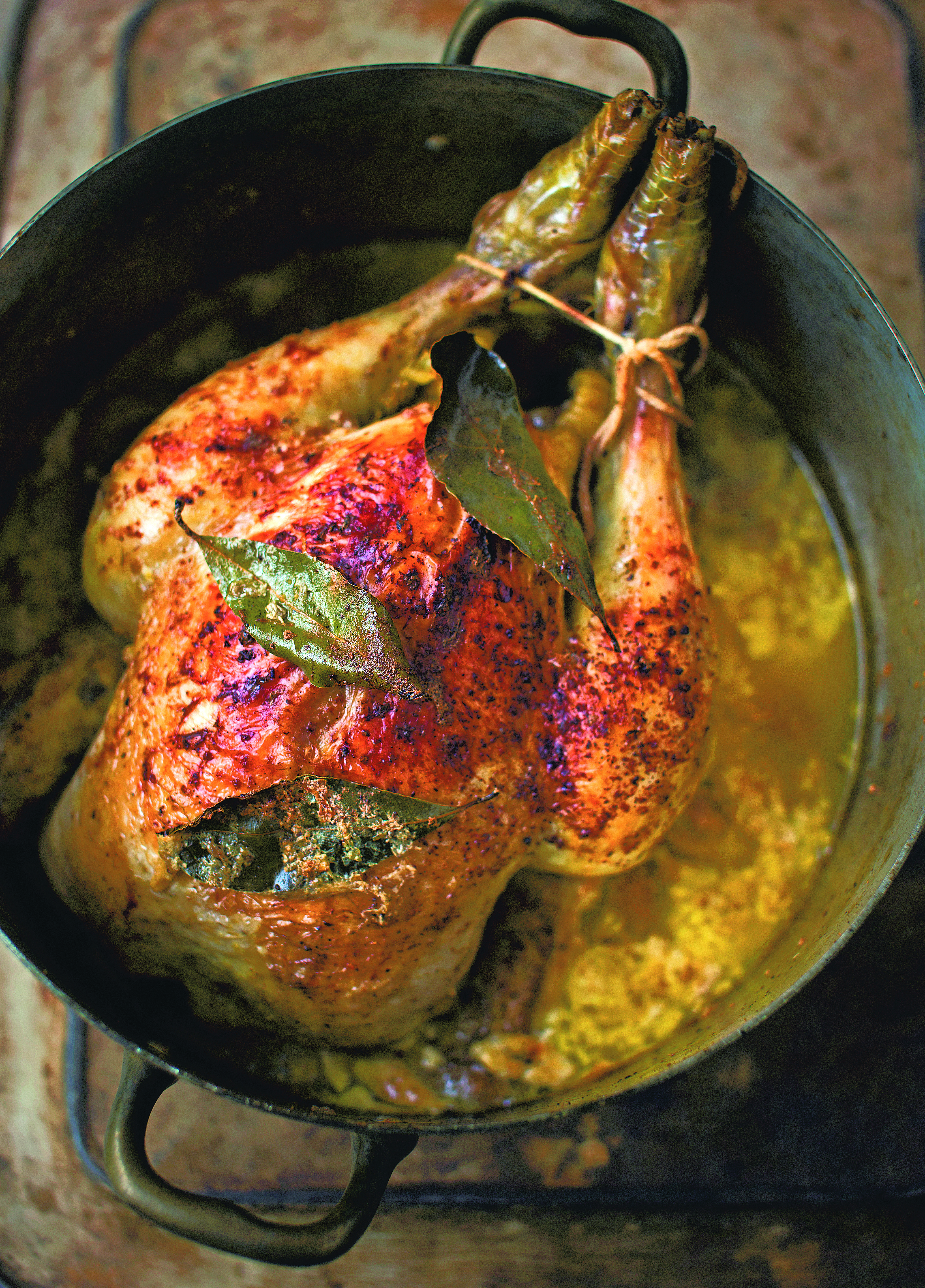 Chicken Pot-Roasted In Milk, Bay And Nutmeg
Chicken Pot-Roasted In Milk, Bay And Nutmeg
I’ve never been keen on the Italian dish of pork cooked in milk, but I was convinced to try this by Faith Durand who runs www.thekitchn.com website. She heard about it from Jamie Oliver and made some adjustments, and I have made my own. Faith thinks it is the best chicken recipe in the world and my children would be inclined to agree with her. You won’t believe me until you try it, but it is a great dish. The chicken stays completely succulent and becomes sweet, imbued with and enriched by the flavorings in the milk. The nutmeggy milk makes it a little like eating roast chicken with bread sauce (but without the hassle of making bread sauce). It is one of the most comforting dishes you could wish for.
Serves 6
2 tbsp unsalted butter
2 tbsp olive oil
salt and pepper
4lb chicken
1½ cups whole milk
10 garlic cloves, peeled but left whole
3 bay leaves
good grating of nutmeg
finely grated zest of 2 unwaxed lemons
Preheat the oven to 350°F. Heat the butter and olive oil in a Dutch oven that can hold the chicken. Season the bird, tie the legs together if you want to, and brown it all over. Use 2 wooden spoons to turn the chicken over, seasoning it as you go. Try to avoid piercing the skin. Pour off the fat left behind in the pan (you don’t need to throw it out because you can keep it to fry potatoes).
Add the milk, garlic, bay leaves, nutmeg, and lemon zest to the pot. Bring to just under a boil, then remove from the heat. Cover and cook in the hot oven for 1½ hours, removing the lid halfway through cooking. Baste occasionally, spooning the milk up over the bird.
At the end of cooking time the bird will be succulent and golden and the juices will be copious and slightly curdled. Squash the garlic cloves with the back of a fork so they break down and flavor the juices. Taste to check if you want to add a little more nutmeg.
Serve—I love it with orzo or a rice pilaf—spooning the juices over the chicken and whatever starch you prefer for a side dish. The vegetable you choose depends on the time of year. In winter it’s good with roast carrots, in the summer roast tomatoes and a salad of bitter leaves.
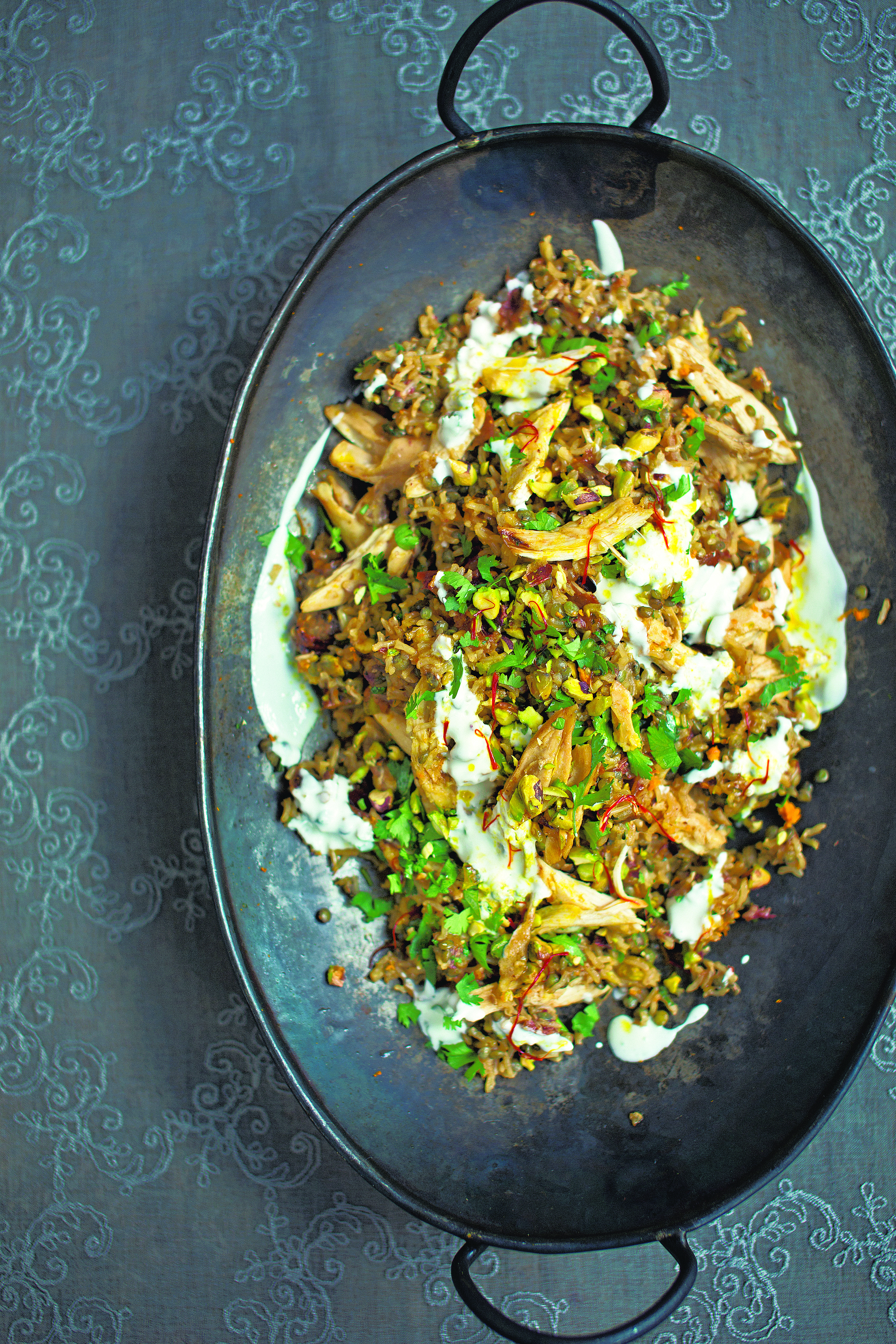 Chicken, Date, And Lentil Brown Rice Pilaf With Saffron Butter
Chicken, Date, And Lentil Brown Rice Pilaf With Saffron Butter
I can’t tell you how often I make a pilaf using this recipe as a blueprint. When I don’t have that much chicken, I sauté an eggplant to extend the “meatiness.” If I’m being careful about carbs, I leave out the dates. If I don’t feel like saffron, I add shredded pieces of preserved lemon to the pilaf and eat it with plain yogurt. Whatever you do, it always ends up greater than the sum of its parts. Pretty luxurious for a dish based on leftovers.
Serves 6
1 tbsp unsalted butter, plus
2 tbsp more for the saffron butter
1 onion, minced
2 garlic cloves, minced
1½ cups brown basmati rice, rinsed until the water runs clear
3 cups chicken stock
12 dates, pitted and cut into thin slices, lengthwise
finely grated zest of 1 orange and juice of ½
1 cup Puy lentils, rinsed
salt and pepper
good squeeze of lemon juice
1 tbsp olive oil
12oz cooked chicken, torn into pieces
3½ tbsp chopped, unsalted pistachios or ¼ cup toasted sliced almonds
¼ cup coarsely chopped cilantro leaves
generous pinch of saffron strands
1¼ cups Greek yogurt
Heat the 1 tablespoon of butter in a heavy saucepan and sauté the onion until soft and pale gold. Add the garlic and cook for another couple of minutes. Now add the rice and stir it around until well coated in the butter and just beginning to toast. Add the chicken stock, dates, and orange zest and bring to a boil. Reduce the heat, cover the pan, and cook for about 30 minutes. The stock will become absorbed during this time; if the rice gets too dry, add a little boiling water.
At the same time, cook the lentils in plenty of boiling water until tender (the lentils are cooked separately because the cooking time can be different from that of the rice; also the lentils make their cooking liquid murky, which doesn’t look so good). The lentils can take anything from 15 to 30 minutes to become tender, depending on their age, but be very careful not to overcook them. They need to retain their shape and can very quickly turn to mush. Once the lentils are cooked, drain, rinse in hot water, and add to the rice. Run a fork through the mixture, season, and add a good squeeze of lemon juice.
Heat the olive oil in a skillet and quickly reheat the cooked chicken. Season. Gently fork the chicken into the cooked rice and lentils along with the nuts, cilantro, and orange juice. The dish should be moist but not “wet.” Taste it for seasoning.
Quickly make the saffron butter: melt the 2 tablespoons of butter in a skillet, add the saffron, and give it a stir to help it color the butter.
Put the rice into a broad shallow bowl, spoon on some yogurt (serve the rest on the side) then pour on the saffron butter. Serve immediately. You don’t want anything complicated on the side (there’s enough going on in this dish). A spinach or watercress salad (add cucumber for crunch) would be perfect.


